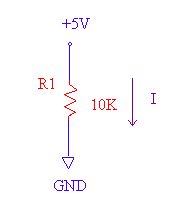
Figure 1.
-
Using a multimeter, measure the actual resistance of the 10K ohm resistor
(before building the circuit).
-
Build the circuit in Figure 1 on the protoboard. With the multimeter set
to measure DC volts, measure the voltage across the resistor.
-
One method used to measure the current through a resistor is to use Ohm's
Law. Using the data you collected from 2a and 2b, calculate the current,
I, through the resistor. Express your answer in milliamps. This is your
experimental value.
-
Calculate the percent difference between the value for I you obtained in
2c, and the theoretical value for I you calculated in problem 1. Write your
answer here.

-
Another method used to measure current through a resistor is to "break" your
circuit, and insert the multimeter into it to complete the connection. Measure
I using the multimeter. Write your answer here.
- Calculate the percent difference between the value for I you obtained in 2e and the theoretical value for I you calculated in problem 1.

Figure 2.
-
Using a multimeter, measure and record the DC voltage across each circuit element.
-
Using Ohm's Law, calculate the values for all the indicated currents in the
circuit. You may use either labeled or measured values for your resistors, but you must note which method you use. Using measured values will generate more accurate results. In either case, your decision here will determine how you explain any error in your results.
-
Using Kirchoff's Current Law, write symbolic node equations for the currents entering
and leaving Nodes 1, 2, and 3. Plug in your values for the currents in the equations and see if KCL holds true. If you have some error here (a nonzero sum), evaluate whether it is reasonable or not (compare the remainder with the smallest value in your equation and calculate a percentage.)
-
Using Kirchoff's Voltage Law, write symbolic loop equations for the three loops in
the circuit. Plug in your measured values for the voltages in the equations and see if KVL holds true. Like the previous step, evaluate error in this equation.
-
Calculate the power delivered or absorbed by all circuit elements (Ps, P1,
P2, P3, and P4). Show that the Law of Conservation of Power is observed by
showing that power sums to (almost) zero for the circuit. Evaluate and explain any error if you get a non-zero result.